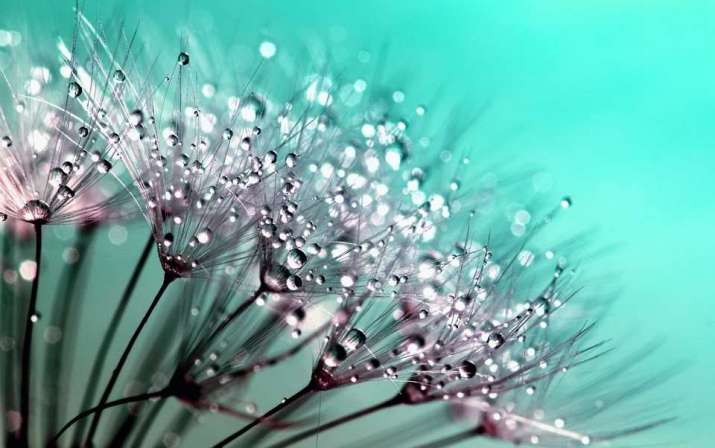FEATURES|COLUMNS|Silk Alchemy
Mindful Expression: Immersion in the Essence of the Moment

The sun was warm. The breeze was calm. I drank some freshwater from my cupped hand and raised my face to the sun, letting the entire experience permeate my being. With my fingers still caressing the cold freshwater, I gazed toward the sea. Wave upon wave of Chantilly cream topped the transparent teal as the diamond-jeweled cerulean rolled into the enclosed pebbled cove. Huge smooth pebbles of slate grey rumbled as the ocean tried to pull them back into its belly. Rumbling as deeply as only ancient stones know how. It was time to move closer to the sea; so close that the ocean spray refreshed my face each time the encroaching water lapped the land. I sat upon a large pebble, one of innumerable stones that have been pounded and caressed smooth by eons of saltwater. I sat and felt the deep reverberation of these fundamental elements like a lullaby sung by the Earth herself.
This is a segment from my previous article for this column, in which I describe a beautiful meditation with nature. Upon writing about my experience I realized how my mind had slipped into a poetic universe where the act of recalling the details had me falling into the magic all over again, fixing the moment into my memory banks like a video recorder. The above text was tempered for a publicly shared narrative and to help maintain the essay’s focus, however, when the recounting of an experience is for our eyes only, then we are free to play with prose like preschoolers with crayons.
I have had forays into poetry; deep dives into the essence of the subject at hand. Dives that activate areas in the brain unlike much else. So this offering today is less a writing tutorial and more about going deeper into meditation, particularly active meditations, in ways that bring a whole-brain creative activation and remind us of the small moments we may overlook or skies so large we forget their enchanting details. My earlier article on ekphrastic poetry was an exploration into deepening a deity relationship in a structured way, however here I wish to encourage a similar exercise that is more expansive.
In numerous studies, often using fMRI and HD EEG technology, scientists have been able to observe which parts of the brain fire up when performing certain activities. Writing with a good old-fashioned pen or pencil on paper has been proven to activate areas of the brain linked to memory recall and learning—a point to consider with younger generations, who only use digital hardware. The act of moving our hand activates the motor cortex, while visualizing the letters and words activates motor-planning aspects of the visual cortex and language use in the temporal and central lobes. The hippocampus holds all our long-term memories, while the frontal lobe, our planning and decision-making control center, cherrypicks from those recollections, organizing them into order. In the left part of the frontal lobe, we also have the Broca’s area, which is responsible for all things in language production, and the Wernicke’s area, which has us understand that language and production of correct syntax.

Deep within the brain sits the caudate nucleus, a part of the brain that, like a muscle, improves its function with practice. Neurons are activated when there is eye and body movement (which is why physical movement is so important for healthy cognitive function), but there is movement when writing. The caudate nucleus is thought to be responsible for learned habits, so creative and lateral thinking habits are a must for writers. To begin with, those who do not exercise this part of the brain in this way may struggle with words, but the more you practice, the easier it becomes. Now, I am all for the whole-brain approach. I am for the de-leftism of plowing every abstract and extraordinary experience through the literal, linear, and “rational” part of the brain, however this really interesting thing occurs when we process the ephemeral through the practice of handwriting—but not simply in a bullet-point fashion, but in that aforementioned poetic expression that links us back to the experience and helps us to extract and evoke every molecule of magic.
So to meditate on the elements and on nature in general; to connect us with one of the most fundamental relationships we have while living upon this planet—and if it feels right for you—do try these exercises, and extend them into whatever other experience you wish to deepen your relationship with. This is beyond journaling—although that is a very interesting and valuable practice for many—this is letting the mind become a painter with words. Let the descriptions communicate back and forth with your physical and emotional body.
Start with the sky. Sit with a pad and pencil and make as many notes as swim through your mind, also paying attention to any somatic and visceral reactions you may experience.
We often forget to look up, to pause and take in the tops of trees and buildings. We forget to marvel at the evening colors, the orange and pink fire behind the smoky whispers of fingers tracing across the Sun, just visible through the golden glow of the evening haze that draws in over a warm summer day, like a soft cotton-candy duvet tucking us in. The lavender mists of an early winter morning and the pastel baby blue sky dappled with hints of powder-pink cotton wool. Treetops peeking through with their twinkling icy crowns to welcome a new day. Even a light matte grey day can give us an opportunity to wax lyrical, connecting and enlivening us to the element of the heavens. The grey is the blank canvas upon which dreams can be etched. Is it the grey that we can fall into? Or the dark seal grey with billowing clouds that look like mountains where the gods of old myth reside?
Now try the same exercise with a plant. This will help connect you with organic nature. If you can, go outside into nature. Even a neighborhood tree will do, should the former two be impossible.

Grab your notepad and pencil again, and sit with your chosen plant. Look at it. Now really look at it. Look at its leaf formation. Look at its coloring: not just “green,” but the type of green; the tones, values, and shades of green. Yellowy greens and white? Greens that look like a blanket of dark fir trees? Look at the size of the leaves and their relationship with each other. Where does your mind wander in relation to the plant? Are you transported to the tropics or the desert, or have you been transported to a magical land of elves and fairies? Are you basking on a stone-baked patio in the warmth of a Mediterranean summer or a nemophilist wallowing in a grove in an ancient Celtic forest? Jot down these thoughts and feelings as you go, if you wish. Once your mind has adventured into wondrous places, note your emotional responses. How do you feel? What can you connect the plant and your feelings with? Do the leaves appear pointed like flames and make you feel fear or heat? Are they a cozy fire on a cold evening? A campfire party on a beach? Or are they the threatening licks of a forest fire coursing through like lava streams down a mountain?
Try this with a body of water, or with fire if it’s safe to do so—a candle will do.
Try it with any social event, with work, with a trip to the supermarket. Every moment, good or bad, has a story to tell. Every story will become more poetic with practice, and you will deepen your connection with the present moment and bring forth an aliveness that will stay in your memory and help guide you as you become increasingly aware of your subconscious reactions and responses.
If you feel you are ready to and want to, you can even try this meditation exercise with the deity of your choosing.
See more
Tilly Campbell-Allen (Dakini as Art)
Related features from Buddhistdoor Global
Sowing the Seeds of Light and Life, Harvesting the Fruit of Rebirth
I Spy with My Magic Eye . . .
The Alchemist’s Bowl
The Song of the Flower














